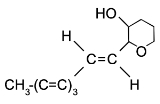
Ichthyothere
Encyclopedia
Ichthyothere is a small genus of about 25 flowering plants, found in parts of South America
(the Amazon) and Central America.
The name ichthyothere literally translates as fish poison. This plant's active constituent is a chemical called ichthyothereol, which is a polyacetylene
compound so toxic to fish
that they will jump out of the water if Ichthyothere terminalis leaves
are used as bait.
This genus is characterized by the small capitulum
with few (usually one or two) fertile ray florets.
It lacks an expanded outer series of herbaceous involucral bract
s or phyllaries. These tend to be much reduced.
Ichthyothere scandens and Ichthyothere garcia-barrigae, both found at elevations above 1,000m, belong to a unique subgenus within Ichthyothere. The other species are small herb
s with an erect stem
, showing tightly clustered or glomerulate groups of capitula. They occur below 1,000 m elevation.
Its taxonomic status has been reversed several times. It was classified in the subtribes Melampodiinae, Milleriinae and then in a group of unclassified taxa. Recent molecular phylogenetic research has now placed the genus Ichthyothere in the subtribe Espeletiinae. It may be a sister taxon to the Espeletia
complex.
South America
South America is a continent situated in the Western Hemisphere, mostly in the Southern Hemisphere, with a relatively small portion in the Northern Hemisphere. The continent is also considered a subcontinent of the Americas. It is bordered on the west by the Pacific Ocean and on the north and east...
(the Amazon) and Central America.
The name ichthyothere literally translates as fish poison. This plant's active constituent is a chemical called ichthyothereol, which is a polyacetylene
Polyacetylene
Polyacetylene is an organic polymer with the repeat unit n. The high electrical conductivity discovered for these polymers beginning in the 1960's accelerated interest in the use of organic compounds in microelectronics...
compound so toxic to fish
Fish
Fish are a paraphyletic group of organisms that consist of all gill-bearing aquatic vertebrate animals that lack limbs with digits. Included in this definition are the living hagfish, lampreys, and cartilaginous and bony fish, as well as various extinct related groups...
that they will jump out of the water if Ichthyothere terminalis leaves
Leaf
A leaf is an organ of a vascular plant, as defined in botanical terms, and in particular in plant morphology. Foliage is a mass noun that refers to leaves as a feature of plants....
are used as bait.
This genus is characterized by the small capitulum
Capitulum
The term Capitulum can refer to several things:*In botany, a type of flower head where the bracts are located under the basis, such as a daisy's*Also in botany, the top of a Sphagnum moss plant with compact clusters of young branches....
with few (usually one or two) fertile ray florets.
It lacks an expanded outer series of herbaceous involucral bract
Bract
In botany, a bract is a modified or specialized leaf, especially one associated with a reproductive structure such as a flower, inflorescence axis, or cone scale. Bracts are often different from foliage leaves. They may be smaller, larger, or of a different color, shape, or texture...
s or phyllaries. These tend to be much reduced.
Ichthyothere scandens and Ichthyothere garcia-barrigae, both found at elevations above 1,000m, belong to a unique subgenus within Ichthyothere. The other species are small herb
Herb
Except in botanical usage, an herb is "any plant with leaves, seeds, or flowers used for flavoring, food, medicine, or perfume" or "a part of such a plant as used in cooking"...
s with an erect stem
Plant stem
A stem is one of two main structural axes of a vascular plant. The stem is normally divided into nodes and internodes, the nodes hold buds which grow into one or more leaves, inflorescence , conifer cones, roots, other stems etc. The internodes distance one node from another...
, showing tightly clustered or glomerulate groups of capitula. They occur below 1,000 m elevation.
Its taxonomic status has been reversed several times. It was classified in the subtribes Melampodiinae, Milleriinae and then in a group of unclassified taxa. Recent molecular phylogenetic research has now placed the genus Ichthyothere in the subtribe Espeletiinae. It may be a sister taxon to the Espeletia
Espeletia
Espeletia, commonly known as Frailejón or Fraylejón is a genus of perennial subshrubs, in the family Asteraceae. The genus, which is endemic mainly to Colombia, Venezuela and Ecuador, was first formally described by botanist Alexander Von Humboldt in 1801...
complex.
Species
- Ichthyothere agrestis
- Ichthyothere angustifolia
- Ichthyothere connata
- Ichthyothere cordata
- Ichthyothere cunabi
- Ichthyothere davidsei
- Ichthyothere dubia
- Ichthyothere elliptica
- Ichthyothere garcia-barrigae
- Ichthyothere grandifolia
- Ichthyothere granvillei
- Ichthyothere hirsuta
- Ichthyothere integrifolia
- Ichthyothere latifolia
- Ichthyothere linearis
- Ichthyothere macdanielii
- Ichthyothere matogrossensis
- Ichthyothere mollis'
- Ichthyothere ovata
- Ichthyothere palustris
- Ichthyothere pastazensis
- Ichthyothere perfoliata
- Ichthyothere peruviana
- Ichthyothere petiolata
- Ichthyothere pruinosa
- Ichthyothere rufa
- Ichthyothere scandens
- Ichthyothere suffruticosa'
- Ichthyothere terminalis
- Ichthyothere ternifolia
- Ichthyothere ulei

